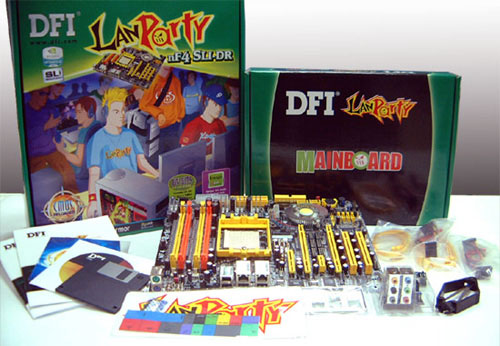The DFI LANParty NF4 SLI-DR
Introduction

Over the past year DFI has rapidly been become the motherboard of choice for enthusiasts and the Do-It-Yourself (DIY) crowd. Part of the reason for their growing Tier 2 market share is great looking boards, but DFI boards are also becoming known for their stability and overclocking potential. DFI has also noted that the packaging, presentation, and bundle is also important, and currently offer one of the best bundles on the market with their LAN Party series. All these factors have helped DFI create a buzz in the industry on almost every board released in recent months. Today LR takes a look at DFI?s latest and greatest motherboard, the LAN Party NF4 SLI-DR for AMD’s socket 939.
Socket 939 made its first appearance in June of 2004, with the promise of incredible performance as well as the ability to use cheaper and better performing unbuffered memory (Its predecessor, the socket 940, required registered memory to operate). Unfortunately, until fairly recently the choices for socket 939 motherboards was limited mostly to the major board makers, and even then, most boards were beset by issues that crippled their performance (i.e. PCI/AGP locks).
With DFI?s philosophy of not having to be first, but being the best, I have eagerly been waiting for the release of their socket 939 solution, and finally my wait is over. With features like SLI (Scaleable Link Interface), PCI-Express, NVidia?s NForce 4 Chipset, SATA II and NCQ (Native Command Queuing) support, Karajan 8 channel audio, as well as DFI?s assortment of management tools, how can you not be excited?
Read on to see how this bad boy stacks up!
Basic Features:
| CPU | ? AMD Athlon 64 FX / Athlon 64 / Sempron ? Socket 939 |
| Chipset | ? NVIDIA nForce4 SLI – Supports NVIDIA SLI (Scalable Link Interface) |
| Front Side Bus | 2000MT/s HyperTransport interface |
| Memory | ? Four 184-pin DDR SDRAM DIMM sockets ? Supports dual channel (128-bit wide) memory interface ? Supports up to 4GB system memory ? Supports DDR266, DDR333 and DDR400 DDR SDRAM DIMM |
| SLI / Single VGA Mode | ? SLI mode – 2 SLI-ready graphics cards (use identical cards) on the PCI Express x16 slots. – The graphics cards are connected via the SLI bridge. – The bandwidth of each slot is x8; when the graphics cards are connected via the SLI bridge, it runs at x16 bandwidth. ? Single VGA mode – 1 PCI Express graphics card on the PCIE1 slot will run at x16 bandwidth. – The other PCI Express x16 slot (PCIE4) will run at x2 bandwidth. |
| BIOS | ? Award BIOS ? CMOS Reloaded ? CPU/DRAM overclocking ? CPU/DRAM/Chipset overvoltage ? 4Mbit flash memory |
| Hardware Monitor | ? Monitors CPU/system/chipset temperature ? Monitors 12V/5V/3.3V/Vcore/Vbat/5Vsb/Vchipset/Vdram voltages ? Monitors the speed of the CPU fan, Fan 2 and chipset fan ? CPU Overheat Protection function monitors CPU temperature during system boot-up |
| Audio | ? Karajan audio module – Realtek ALC850 8-channel audio CODEC – 6 audio jacks – 1 CD-in connector – 1 front audio connector ? S/PDIF-in/out interface |
| LAN | ? Dual Gigabit LAN – Vitesse VSC8201 Gigabit Phy and Marvell 88E8001 Gigabit PCI ? Fully compliant to IEEE 802.3 (10BASE-T), 802.3u (100BASE-TX) and 802.3ab (1000BASE-T) standards |
| IDE | ? nForce4 chip supports two IDE connectors that allows connecting up to four UltraDMA 133Mbps hard drives ? NVIDIA RAID allows RAID arrays spanning across Serial ATA and Parallel ATA ? RAID 0 and RAID 1 |
| SATA w/ RAID | ? Four Serial ATA ports supported by the nForce4 chip – SATA speed up to 3Gb/s – RAID 0 and RAID 1 – NVIDIA RAID allows RAID arrays spanning across Serial ATA and Parallel ATA ? Four Serial ATA ports supported by the Silicon Image Sil 3114 chip – SATA speed up to 1.5Gb/s – RAID 0, RAID 1 and RAID 5 |
| IEEE 1394 | ? VIA VT6307 ? Supports two 100/200/400 Mb/sec ports |
| Rear Panel I/O Ports | ? 1 mini-DIN-6 PS/2 mouse port ? 1 mini-DIN-6 PS/2 keyboard port ? 2 S/PDIF RCA jacks (S/PDIF-in and S/PDIF-out) ? Karajan audio module (6 audio jacks) ? 1 IEEE 1394 port ? 2 RJ45 LAN ports ? 6 USB 2.0/1.1 ports |
| I/O Connectors | ? 2 connectors for 4 additional external USB 2.0/1.1 ports ? 1 connector for 1 external IEEE 1394 port ? 1 connector for 1 external serial port ? 1 front audio connector for external line-out and mic-in jacks (on the Karajan audio module) ? 1 CD-in internal audio connector (on the Karajan audio module) ? 1 S/PDIF connector for optical cable connection ? 1 IR connector ? 8 Serial ATA connectors ? 2 IDE connectors ? 1 floppy connector ? 1 24-pin ATX power connector ? 1 4-pin ATX 12V power connector ? 2 4-pin 5V/12V power connectors (FDD-type and HDD type) ? 1 front panel connector ? 5 fan connectors ? 4 diagnostic LEDs ? 1 diagnostic LED connector for external 4 diagnostic LEDs display ? EZ touch switches (power switch and reset switch) |
| Expansion Slots | ? 2 PCI Express x16 slots ? 1 PCI Express x1 slot ? 1 PCI Express x4 slot ? 2 PCI slots |
| PCB | ? ATX form factor ? 24cm (9.45″) x 30.5cm (12″) |

Comments are closed.